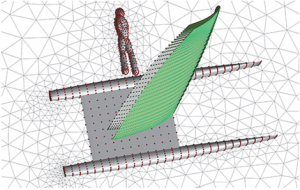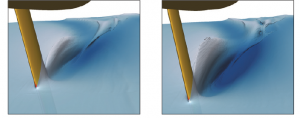Multi-objective Optimization of A-Class Catamaran Foils




The design of sailing boats appendages requires taking in consideration a large amount of design variables and diverse sailing conditions. The operative conditions of dagger boards depend on the equilibrium of the forces and moments acting on the system. This equilibrium has to be considered when designing modern fast foiling catamarans, where the appendages accomplish both the tasks of lifting up the boat and to make possible the upwind sailing by balancing the sail side force. In this scenario, the foil performing in all conditions has to be defined as a trade-off among contrasting needs.
 The multi-objective optimization, combined with experienced aerodynamic design, is the most efficient strategy to face these design challenges. For this reason a joint project including the university or Rome “Tor Vergata”, the aerospace engineering consulting firm Design Methods and the software vendors RBF Morph and ESTECO, has been developed to setup a pilot study, about the design of the foils for an A-Class catamaran, to demonstrate capabilities and the potentialities of combining cutting edge mesh morphing technologies and optimization design environments by developing a highly constrained multi-objective optimization procedure.
The multi-objective optimization, combined with experienced aerodynamic design, is the most efficient strategy to face these design challenges. For this reason a joint project including the university or Rome “Tor Vergata”, the aerospace engineering consulting firm Design Methods and the software vendors RBF Morph and ESTECO, has been developed to setup a pilot study, about the design of the foils for an A-Class catamaran, to demonstrate capabilities and the potentialities of combining cutting edge mesh morphing technologies and optimization design environments by developing a highly constrained multi-objective optimization procedure.
The implementation of strongly constrained geometric parameterization often suggests adopting a parametric CAD system coupled to a numerical domain regeneration procedure. In this paper, we want to demonstrate the efficiency of the mesh morphing approach based on Radial Basis Functions (using RBF Morph).

The optimization procedure in combining two-phases CFD simulations of the foils, using the ANSYS Fluent solver, with the mesh morphing tool RBF Morph within the ESTECO modeFRONTIER optimization workflow.
The design variables control the foil planform and the front shape subjected to geometrical constraints. The objective functions are defined to improve the performances in upwind (navigation against the wind) and downwind (navigation with the wind) sailing conditions at two values of boat speed.
Click here for more information.
